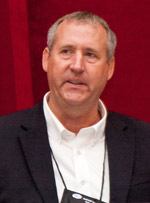General Session II
The National Beef Quality Audit:
What’s it Mean to a Cattle Feeder?
by Troy Smith for Angus Productions Inc.
HOUSTON, Texas (April 20, 2012) — Among topics discussed at the 2012 Beef Improvement Federation (BIF) Research Symposium, In Houston, Texas, were results of the most recent National Beef Quality Audit (NBQA). During the symposium’s second general session, panel members representing various beef industry segments explained how audit results affect their operations. Representing the cattle feeding sector was Dan Dorn, supply development coordinator for Decatur County Feedyard, Oberlin, Kan.

Dan Dorn
Dorn said the company feeds cattle for retained ownership customers from across the United States. He said he believes quality audits probably have raised awareness of beef quality issues among producers. Some of them are doing a fine job and, on average, there has been improvement. But he’s convinced that some people still don’t care about the beef consumer enough to make needed changes in the way they do things.
“We still see lots of lumps at injection sites and other quality defects in cattle sent to the feedyard. Sometimes we’re expected to take a sow’s ear and turn it into a silk purse,” stated Dorn. “There’s still a need for improvement.”
Dorn talked about Decatur County Feedyard’s own “profit audit” and cited the wide range of value represented within sets of feeder cattle coming into the yard. Due to inconsistencies and lack of uniformity, there can be a $200 spread in grid value when cattle are marketed, and there can be huge differences in the cost of feeding them.
Citing changes from 2008 to 2011, Dorn said, average daily gains are up. The percentage of carcasses qualifying for the Choice quality grade is up, and the percentage of Yield Grade 4 carcasses is down. Carcass weights are lighter, and the average for ribeye area hasn’t changed. Overall health costs have been nearly static.
“Any changes have been relatively small,” said Dorn, also noting that feed efficiency is the big profit driver. “As cattle feeders,” he added, “we’re simply going to follow the money.”
Return to the Newsroom for links to the PowerPoint presentation that accompanied this presentation.
Editor’s Note: This summary was written under contract or by staff of Angus Productions Inc. (API). Through an agreement with the Beef Improvement Federation, we are encouraging reprinting of the articles to those who will adhere to the reprint guidelines available on this site. Please review those guidelines or contact Shauna Rose Hermel, editor, at 816-383-5270. PowerPoints are posted with permission of the presenter and may not be reproduced in whole or in part without the express permission of the presenter.
API's coverage of the event is made possible through collaboration with BIF and sponsorship of LiveAuctions.tv. For questions about this site, or to notify us of broken links, click here.
Headquartered in Saint Joseph, Mo., API publishes the Angus Journal, the Angus Beef Bulletin, the Angus Beef Bulletin EXTRA, and the Angus e-List, as well as providing online coverage of events and topics pertinent to cattlemen through the API Virtual Library.



